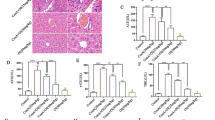Abstract
Hepatic cryoablation can produce acute lung injury, with activation of nuclear factor (NF)-кB in the remnant liver and lungs, production of C-X-C chemokines, and neutrophil infiltration of the lungs. Ac-tivated complement stimulates NF-к B and cytokine secretion from Kupffer cells. The role of comple-ment in the development of acute lung injury after cryoablation was examined using HLL transgenic mice (5’ HIV-LTR-Luciferase gene; 5’ HIV-LTR is an NF-к B-dependent promoter). Total comple-ment depletion was achieved with preoperative administration of cobra venom factor (CVF). After he-patic cryoablation, bioluminescent NF-кB activity increased in the nonablated liver remnant by 4 hours in both control (119,093 ± 22,808 net RLU/mg protein) and CVF-treated mice (117,722 ± 14,932) from cumulative baseline (657 ± 90, P < 0.0001). In the lung, complement-depletion induced significantly greater increases in NF-к B activation at both early and later times. Likewise, chemokines were higher in complement-depleted mice relative to controls (KC: 493 ± 43 versus 269 ± 29 pg/mg protein, P < 0.001; MIP-2: 171 6 29 versus 64 6 13 pg/mg protein, P < 0.0001). Pulmonary myelo-peroxidase activity was equivalent at 24 hours, but complement-depletion caused a significantly more rapid influx of neutrophils. Complement depletion results in increased pulmonary inflammation follow-ing liver cryo injury via relative upregulation of NF-к B activity. Activated complement is not the initiator of the systemic inflammatory response; in fact, downstream components of the complement cascade may diminish subsequent inflammation.
Similar content being viewed by others
References
Weaver ML, Atkinson D, Zemel R. Hepatic cryosurgery in treating colorectal metastases. Cancer 1995;76:210–214.
Korpan NN. Hepatic cryosurgery for liver metastases. Long-term follow-up. Ann Surg 1997;225:193–201.
Shafir M, Shapiro R, Sung M, et al. Cryoablation of unre-sectable malignant liver tumors. Am J Surg 1996;171:27–31.
Chapman WC, Debelak JP, Wright Pinson C, et al. Hepatic cryoablation, but not radiofrequency ablation, results in lung inflammation. Ann Surg 2000;231:752–761.
Cozzi PJ, Englund R, Morris DL. Cryotherapy treatment of patients with hepatic metastases from neuroendocrine tu-mors. Cancer 1995;76:501–509.
Gagne DJ, Roh MS. Cryosurgery for hepatic malignancies. In: Curley SA, ed. Liver Cancer. New York: Springer-Verlag, 1998, pp 173–200.
Seifert JK, Morris DL. World survey on the complications of hepatic and prostate cryotherapy. World J Surg 1999;23:109–113.
Haddad FF, Chapman WC, Wright JK, et al. Clinical expe-rience with cryosurgery for advanced hepatobiliary tumors. J Surg Res 1998;75:103–108.
Blackwell TS, Debelak JP, Venkatakrishanan A, et al. Acute lung injury after hepatic cryoablation: correlation with NF-kappa B activation and cytokine production. Surgery 1999; 126:518–526.
Sadikot RT, Wudel LJ, Jansen DE, et al. Hepatic cryoabla-tion-induced multisystem injury: bioluminescent detection of NF-kappaB activation in a transgenic mouse model. J GASTROINTEST SURG 2002;6:264–270.
Glasgow SC, Ramachandran S, Csontos KA, et al. Interleu-kin 1 is prominent in the early pulmonary inflammatory re-sponse following hepatic injury. Surgery 2005;138:64–70.
Washington K, Debelak JP, Gobbell C, et al. Hepatic cryoa-blation-induced acute lung injury: histopathologic findings. J Surg Res 2001;95:1–7.
Arumugam TV, Shiels IA, Woodruff TM, et al. The role of the complement system in ischemia-reperfusion injury. Shock 2004;21:401–409.
Pan ZK. Anaphylatoxins C5a and C3a induce nuclear factor [kappa]B activation in human peripheral blood monocytes. Biochim Biophys Acta Gene Struct Expression 1998;1443:90–98.
Czermak BJ, Lentsch AB, Bless NM, et al. Synergistic en-hancement of chemokine generation and lung injury by C5a or the membrane attack complex of complement. Am J Pathol 1999;154:1513–1524.
Puschel GP, Hespeling U, Oppermann M, et al. Increase in prostanoid formation in rat liver macrophages (Kupffer cells) by human anaphylatoxin C3a. Hepatology 1993;18:1516–1521.
Riedemann NC, Guo R-F, Hollman TJ, et al. Regulatory role of C5a in LPS-induced IL-6 production by neutrophils during sepsis. FASEB J 2004;18:370–372.
Morgan BP, Harris CL. Complement therapeutics; his-tory and current progress. Mol Immunol 2003;40:159–170.
Xu Y, Ma M, Ippolito GC, et al. Complement activation in factor D-deficient mice. Proc Natl Acad Sci U S A 2001;98:14577–14582.
Oberholzer J, Yu D, Triponez F, et al. Decomplementation with cobra venom factor prolongs survival of xenografted is-lets in a rat to mouse model. Immunology 1999;97:173–180.
Hensley P, O’Keefe MC, Spangler CJ, et al. The effects of metal ions and temperature on the interaction of cobra venom factor and human complement factor B. J Biol Chem 1986;261:11038–11044.
Wudel LJ Jr, Allos TM, Washington MK, et al. Multi-organ inflammation after hepatic cryoablation in BALB/c mice. J Surg Res 2003;112:131–137.
Manthorpe M, Cornefert-Jensen F, Hartikka J, et al. Gene therapy by intramuscular injection of plasmid DNA: studies on firefly luciferase gene expression in mice. Hum Gene Ther 1993;4:419–431.
Bradford MM. A rapid and sensitive method for the quantita-tion of microgram quantities of protein utilizing the principle of protein-dye binding. Anal Biochem 1976;72:248–254.
Goldblum SE, Wu KM, Jay M. Lung myeloperoxidase as a measure of pulmonary leukostasis in rabbits. J Appl Physiol 1985;59:1978–1985.
Schierwagen C, Bylund-Fellenius AC, Lundberg C. Im-proved method for quantification of tissue PMN accumula-tion measured by myeloperoxidase activity. J Pharmacol Methods 1990;23:179–186.
Schultz J, Kaminker K. Myeloperoxidase of the leukocyte of normal human blood. I. Content and localization. Arch Bio-chem Biophys 1962;96:465–467.
Strey CW, Markiewski M, Mastellos D, et al. The proin-flammatory mediators C3a and C5a are essential for liver regeneration. J Exp Med 2003;198:913–923.
Bhatia M, Saluja AK, Singh VP, et al. Complement factor C5a exerts an anti-inflammatory effect in acute pancreatitis and associated lung injury. Am J Physiol Gastrointest Liver Physiol 2001;280:G974-G978.
Foxman EF, Campbell JJ, Butcher EC. Multistep navigation and the combinatorial control of leukocyte chemotaxis. J Cell Biol 1997;139:1349–1360.
Author information
Authors and Affiliations
Corresponding author
Rights and permissions
About this article
Cite this article
Glasgow, S.C., Kanakasabai, S., Ramachandran, S. et al. Complement depletion enhances pulmonary inflammatory response after liver injury. J Gastrointest Surg 10, 357–364 (2006). https://doi.org/10.1016/j.gassur.2005.06.033
Issue Date:
DOI: https://doi.org/10.1016/j.gassur.2005.06.033




